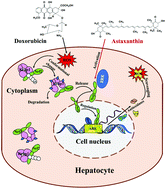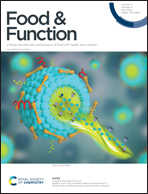Astaxanthin from Haematococcus pluvialis ameliorates the chemotherapeutic drug (doxorubicin) induced liver injury through the Keap1/Nrf2/HO-1 pathway in mice†
Abstract
The aim of this study is to probe a new function of astaxanthin (AST) from Haematococcus pluvialis on chemotherapeutic drug induced liver injury in mice. Doxorubicin-induced liver injury was treated with different doses of AST, and the body weight, food intake, urinalysis, liver function, and oxidative stress indexes were examined. The hepatocyte apoptosis level, pathological sections of liver tissue and the expression of antioxidant related genes were also determined. This study found that DOX could induce serious liver injury through cytotoxicity. AST treatment could decrease the level of liver function indexes (ALT, GOT, ALP and TBil), reduce the concentration of MDA and ROS, and increase the activities of SOD, CAT and GPX in the liver. AST could also repair the damaged hepatocyte in mice with liver injury and reduce the degree of the cellular apoptosis. In addition, AST could interfere with the expression of some related genes in the Keap1/Nrf2 signaling pathway by downregulating the expression of Keap1 and activating the transcription factor Nrf2 via enhancing the level of ERK, which upregulates downstream peroxiredoxins. The present research found and illustrated a new food function of AST, indicating that AST could be used in the therapy of chemotherapy induced side effects.



 Please wait while we load your content...
Please wait while we load your content...